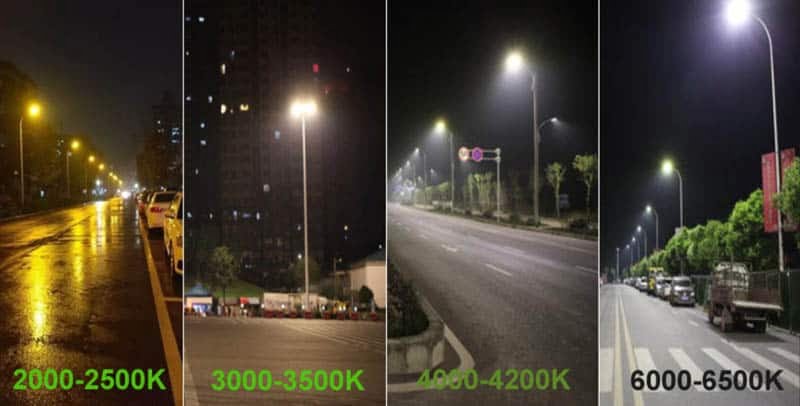Choosing the Right Color Temperature CCT for Your Solar Street Light Project
Understanding Solar Street Light Color Temperature ( CCT ): Kelvin
Kelvin is commonly used as a measurement of the color temperature of a light source. The principle of color temperature is based on the frequency distribution characteristics of light emitted by a blackbody radiator at its temperature. Blackbody temperatures below around 4000K appear reddish, while those above 4000K appear bluish, with 7500K appearing blue.
Generally, the Kelvin temperature of a lamp will fall between 2000K and 6500K.

Kelvin temperatures below 3000 produce warm, calm, and inviting light, suitable for general indoor lighting in homes and businesses. Pros: Shorter wavelength yellow light has strong penetration on rainy days. Cons: Low visibility.
LED lights in the 3000K-4500K range are called neutral light. These bright and vibrant lights are very suitable for workplaces such as basements, factories, and hospitals. Pros: 4000-4500K is closest to natural light, the light is softer and can provide higher brightness while maintaining driver attention. Cons: Not as high visibility as above 5000K.
Lights with Kelvin temperatures in the range of 4500K-6500K are called cool white light, producing a fresh color similar to sunlight. These lights are best when maximum illumination is needed, such as for safety lighting, display cabinets, warehouses, and industrial areas. Highest visibility reduces accidents, especially those above 5700K, are popular for engineering projects. Cons: Can cause fatigue and should not be used in long-term workspaces.
LED Solar Street Light CCT Standards
In most countries, four common color temperature options for LED lights are 2700K (some manufacturers write it as 3000K), 3000K, 3500K, 4000K, 5700K (some manufacturers write it as 6000K), with other color temperatures being customized.

Road Lighting Color Temperature Illumination Ranges
Highway Lighting CCT
Some countries’ regulations (such as China) specify that the color temperature should not exceed 5000K, preferably choosing a medium to low color temperature. However, many engineering projects in various countries still choose 5700K or even above 6000K because the advantages of high color temperature are also significant, improving visibility and reducing accidents.
Color Temperature Requirements for Airport Road Lighting
According to the technical standards for civil airport flight areas, when using LED as a light source, a lens should be added to control glare, and the color temperature should not exceed 4000K.
Residential Area Road Lighting CCT
For roads with mixed motor vehicle and pedestrian traffic in residential areas, it is advisable to use light sources with low to medium color temperatures, most commonly kept below 4000K.
Color Temperature Requirements for Roads with Rain and Fog
Lights along rivers and foggy road sections should use low color temperature lights, with a recommended range of 2700K-3500K.
Commercial Area Road Lighting Color Temperature
In commercial bustling areas, historic and cultural districts, scenic spots, and other places where color recognition is important for motor vehicle traffic, it is advisable to use high CRI, low to medium color temperature light sources.
Parking Lot Road Lighting CCT
5700-6500K is preferable. A 5700K color temperature can help focus attention and make driving safer.
Color Temperature Requirements for Garden and Industrial Lighting
Spotlights, outdoor floodlights, and other landscape lights used in gardens, road decorations, partial lighting, and other outdoor recreational areas. Generally, warm colors of 2700K and 3000K are more suitable, creating a warm and relaxing atmosphere.


